John Deere Logo and the History Behind the Company
This is a look at the John Deere Logo and the history of the business.
John Deere’s first official logo was introduced in 1876. It featured the image of a deer jumping over a log, with the name of the Company in all-caps forming an arc above the deer. The name of the town, Molline, Ill, was placed below the deer and log image.
John Deere is a world-famous brand owned by Deere & Company, an American firm that mainly manufactures heavy-duty machinery for agricultural and construction projects. From its humble beginnings in 1836 when John Deere invented the steel plow, the Company now stands as one of America’s largest farm and industrial equipment manufacturers.

Their first logo stayed in use for more than three decades before fresh changes were introduced in 1910. This second version took on a similar style, but the elements looked a bit more refined. A slogan was added at the bottom: “The Trade Mark of Quality Made Famous by Good Implements.”
The entire logo still used black on white, which remained the sole color choice until the year 2000, when the modern green and yellow were introduced to usher in the new millennium.
John Deere Logo Evolution
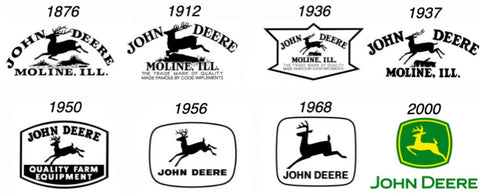
According to official company sources, the first logo version featured a type of deer not found in North America but Africa. Later versions featured the correct deer, each one having slight differences in the manner of the animal’s leap.
Although the John Deere logo has evolved through many iterations since the beginning, the central theme of a leaping deer has been retained ever since.
1876 – 1910
The Company had been in existence for some time by the time John Deere decided to register its first logo in 1876. That logo, however, had been in use for three years, just not officially registered. By this time, the Company was making well over 60,000 plows per year. This is why management saw it fit to trademark their symbol to protect their products from counterfeiting and deception.
1910 – 1936
The second iteration of the Company’s logo came in 1910, although it was not registered until 1912. While the overall design stayed mostly the same, this version introduced higher-definition typography, making it look much sharper than its predecessor. A new slogan spanning two lines was added at the bottom, reading “The Trade Mark of Quality Made Famous by Good Implements.”
1936
In 1936, the Company’s standardization committee wanted to make it easier to print the logo on their products. For this reason, the deer image was simplified to a plain, minimalistic black. However, a 12-sided border was introduced, and it seemed to be out of line with the new purpose, as it only succeeded in making the logo looking even more cluttered. This is probably why this iteration lasted only until 1937.
1937
In 1937, the design team decided to do away with the border and the long slogan at the bottom. The result was a more minimalistic, cleaner design. The brand name and location inscription now implemented a thicker weight of the font to make them stand out more.
1950 – 1956
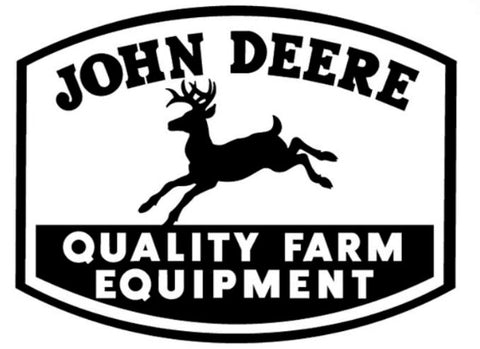
1950 was the year that the logo design took on a new direction. The jumping deer stayed on, in silhouette form, but the log was done away with presumably to reduce clutter. A new 4-sided outline was introduced, with the upper and lower lines curving slightly outwards. However, the outline did not appear entirely out of place, not like the 1936 version, at least.
The slogan introduced in the 1910 version was replaced with a new one: “Quality farm equipment,” in white capital letters on a black background. The inscription Moline, Illinois, was also done away with since the brand now had a global reach.
1956 – 1968
The John Deere logo again took on an almost entirely new look in 1956. This version was the most minimalistic in the brand’s history, with only the leaping deer silhouette and the brand name beneath it. This was also the first time that the wordmark moved from a serif typeface to a sans-serif. The outline was retained but changed to an ellipse/rounded rectangle.
1968 – 2000
The 1968 version retained the overall design concept of its predecessor but was revised to look more clean-cut and contemporary. The deer silhouette was streamlined to show two legs, instead of four, with straight-angled edges that made for a crisper look. In a company memo introducing the changes, it was announced that the new trademark “provides for better reproduction and greater readability under a wider range of usage.”
Current John Deere Logo
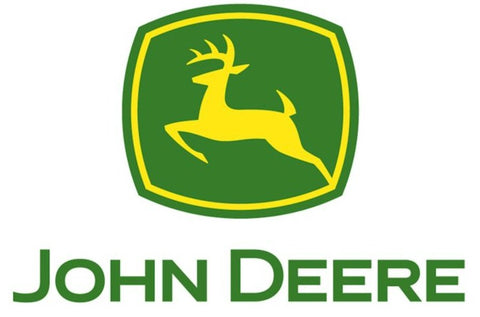
The year 2000 saw the John Deere brand unveil a new, modernistic trademark. This is the first time ever that the Company departed from the classic black and white color palette to green and yellow.
The John Deer logo had been long known as the leaping deer, but this was the first time the deer was made to leap upwards instead of a horizontal landing direction.
John Deere Logo Design Elements
Logo Shape
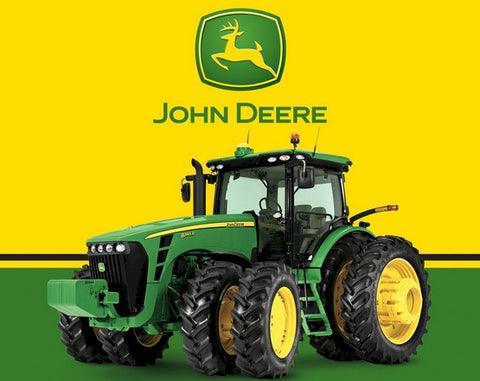
After a few touch-ups to the 1968 version, the John Deere logo now takes the shape of a green curvilinear rectangle, with an inner yellow lining that encloses the deer, which is also yellow.
Symbol
Right from its inception, the John Deere symbol has always relied on the symbolism of a leaping deer. After many improvements throughout the years, the deer has become more graceful—a testament to the strides the Company has managed so far. The John Deer symbol communicates the brand’s incessant rush for progress and prosperity.
Logo Font
The current logo iteration uses a typeface that most closely matches Trade Gothic Bold Extended. Legibility was one of the top factors in the choice of font for the John Deere logo. The designers wanted a font that was stylish but still readable on miniature labels. In the early years of the brand, the inscription used a serif typeface in extra-bold letters. The font finally shifted to a sans-serif in 1968.
Logo Color
Up until 2000, the John Deere logo exclusively used black and white, which were the Company’s traditional colors. The current logo’s choice of green and yellow reflects warmth, as well as a sense of satiety. The colors also communicate the mission of the Company—building machines and tools that help us take care of the basic necessities.
The History of the John Deere Brand

The history of John Deere dates way back to 1836 after John Deere’s steel plow invention. With this implement, it became much easier to till the prairie soil of Midwest America, all without clogging. Deere then went on to build a business that manufactured and marketed the plow before formally incorporating it in 1968 as Deere & Company. Since the firm’s inception, there have been five generations of the Deere family steering the Company forward.
The 1960s and ’70s were a fertile period for the Company, thanks to more farmers embracing a large-scale farming approach to maximize profitability. This trend had a massive impact on Deere & Company, leading to an increased focus on manufacturing farm machinery for large agricultural enterprises. The Company ramped up its production of balers, giant tractors, harvesters, and other heavy-duty farming equipment.
However, in order to keep up with the production needs of small and medium-scale farming operations, the Company had to adopt the “flexible-manufacturing” production system. This system was seen as the solution to serving both small-scale farmers in addition to the ever-increasing market demands of large-scale enterprises.
Under the “flexible-manufacturing” system, the firm was able to set up a new factory in Iowa at the cost of $1.5 billion. This new plant made extensive use of robots and computer technology to run numerous small assembly lines for different equipment, without sacrificing profits even at low output levels. This strategy effectively made Deere & Company the largest farm equipment manufacturer in the U.S. by the end of the 20th century.
Key People in John Deere’s Leadership
The John Deere brand would never have survived without one man’s determination, and that man is John Deere himself. And with the Company’s commitment to building the best machinery for farmers, it is also important to recognize some of the key figures in leadership since John.
Charles Deere (1886 – 1907)
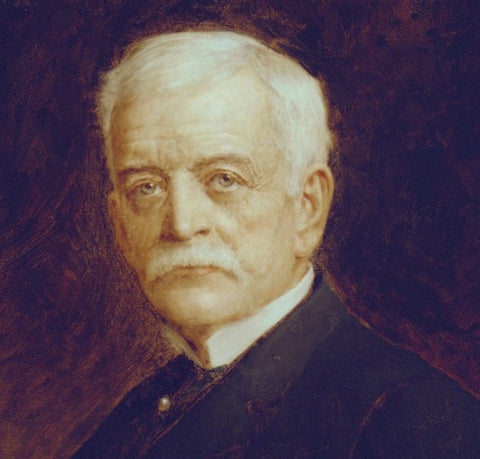
Charles Deere was the second son of John. He took over the reins of the business in 1886, right before his father passed away. Charles used his experience in sales to establish the Company’s first sales branch in Kansas City. The feedback from this sales branch proved critical to the firm’s development of new products. Charles passed away in 1907, by which time he’d made the Company one of the top implement manufacturers in the country.
William Butterworth (1907 – 1936)
William Butterworth was Charles’ son-in-law and took over from him in 1907, just 15 years after joining the Company as an assistant. His big move was to consolidate the Company’s operations into one entity. The 11 factories and 25 sales teams came under one roof under the modern Deere & Company. William also expanded the product line, which included the introduction of the combine harvester in 1912. He went on to retire in 1928 and passed on in 1936.
Charles Deere Wiman (1928 – 1955)

As John Deere’s grandson, Charles Deere Wiman took over from his uncle William Butterworth, having started as a line employee. Wiman faced major hardships during the Great Depression but worked hard to keep the Company going. His time saw the introduction of the renowned Model “A” tractor in 1934. A similar tractor, Model “B,” followed in 1935. Wiman’s dedication helped move the Company forward in the most difficult of times for the manufacturing industry.
William Hewitt (1955-1982)
Hewitt was appointed director in 1950, just two years after he’d joined the firm as a territory manager. He took over from Wiman, his father-in-law, after the latter passed on in 1955. During this period, the Company established itself as an international player with the acquisition of a German tractor company and a large purchase of land in Monterrey, Mexico. The Company grew its worldwide reach and also introduced new tractor models—dubbed “New Generation of Power”—in 1960.
Robert Hanson (1982-1990)
Hanson was not a relation of John Deere, but he did leave a mark in the Company’s history. He not only managed to keep the Company afloat during the recessions of the 1980s but also exceeded sales targets. In 1985, John Deer diversified into the health market under the name John Deere Health Care, Inc.
Hans Becherer (1990 – 2000)
Becherer took over from Hanson upon being elected chairman in 1990. He stressed some of the Company’s top values since its inception, mainly the dedication to innovation. Thanks in part to the Company’s increased global reach, major changes were introduced under Becherer’s stewardship. Key among them was the streamlining and separation of the Company’s divisions, such as Deere’s lawn and ground care department.
Robert W. Lane (2000 – 2009)
Robert Lane had previously managed a number of operations in the Company’s Worldwide Construction Equipment Division. This experience provided some valuable insights into what the Company needed to improve on to keep growing on the global scene.
Lane established the Shareholder Value Added (SVA) model, which helped the Company attain world-class stature in the area of asset efficiency and ROI. Efforts included a modernization program for the firm’s factories around the world as well as upgrading dealer organizations to help serve customers better.
Robert Lane was succeeded by Samuel R Allen, the current CEO, upon his retirement in 2009.
Final Thoughts
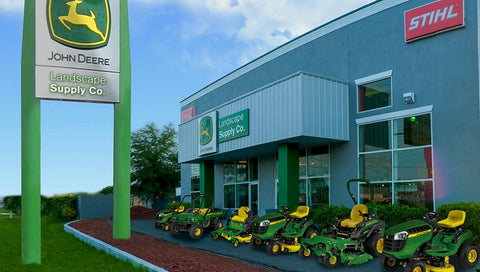
The John Deere Farm and Agricultural Logo is a household image, brand, and symbol in the farming business, with a long history stretching all the way back to 1936. Thanks to the Company’s commitment to constant innovation, as well as a fairly consistent brand image, the John Deere brand has achieved worldwide recognition and continues to push industry and agriculture forward.
In addition to the manufacture of farm machinery, the Company also operates plants that produce a variety of industrial equipment, such as bulldozers, forklifts, tractors, lawn-care equipment, and chain saws. These plants are distributed across several countries around the world, including the United States, Argentina, South Africa, and Canada.


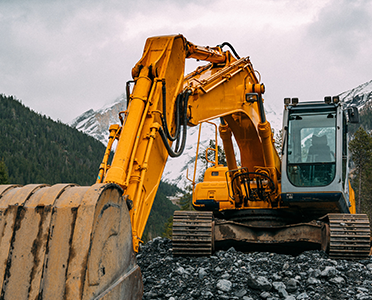




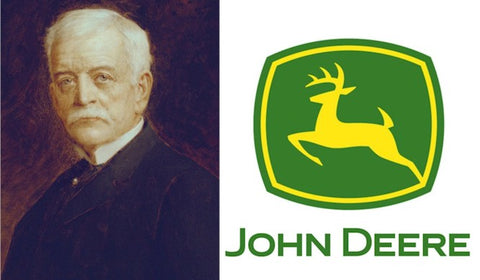









 Contact Us
Contact Us
 Help Center
Help Center
 Chat Online
Chat Online


